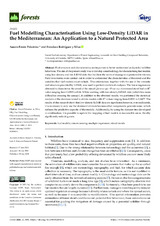Mostrar el registro sencillo del ítem
Fuel Modelling Characterisation Using Low-Density LiDAR in the Mediterranean: An Application to a Natural Protected Area
| dc.contributor.author | Ferrer Palomino, Aurora | |
| dc.contributor.author | Rodríguez y Silva, Francisco | |
| dc.date.accessioned | 2021-07-30T09:42:03Z | |
| dc.date.available | 2021-07-30T09:42:03Z | |
| dc.date.issued | 2021 | |
| dc.identifier.uri | http://hdl.handle.net/10396/21546 | |
| dc.description.abstract | Fuel structure and characteristics are important to better understand and predict wildfire behaviour. The aim of the present study was to develop a methodology for characterising fuel models using low-density and free LiDAR data that facilitate the work of managers of protected territories. Field inventories were carried out in order to understand the characteristics of the stand and the variables that fuel models must include. This information, together with the use of the intensity and structure provided by LiDAR, was used to perform statistical analyses. The linear regressions obtained to characterise the stand of the mixed Quercus spp.–Pinus ssp.-dominated stand had an R2 value ranging from 0.4393 to 0.66. While working with low-density LiDAR data (which has more difficulties crossing the canopy), in addition to the obtained results, we performed the statistical analysis of the dominant stand to obtain models with R2 values ranging from 0.8201 to 0.8677. The results of this research show that low-density LiDAR data are significant; however, in mixed stands, it is necessary to only use the dominant stratum because other components generate noise, which reduces the predictive capacity of the models. Additionally, by using the decision tree developed in combination, it is possible to update the mapping of fuel models in inaccessible areas, thereby significantly reducing costs. | es_ES |
| dc.format.mimetype | application/pdf | es_ES |
| dc.language.iso | eng | es_ES |
| dc.publisher | MDPI | es_ES |
| dc.rights | https://creativecommons.org/licenses/by/4.0/ | es_ES |
| dc.source | Forests 12(8), 1011 (2021) | es_ES |
| dc.subject | Fuel models | es_ES |
| dc.subject | Remote sensing | es_ES |
| dc.subject | Multiple regression | es_ES |
| dc.subject | Mixed stands | es_ES |
| dc.title | Fuel Modelling Characterisation Using Low-Density LiDAR in the Mediterranean: An Application to a Natural Protected Area | es_ES |
| dc.type | info:eu-repo/semantics/article | es_ES |
| dc.relation.publisherversion | http://dx.doi.org/10.3390/f12081011 | es_ES |
| dc.relation.projectID | Gobierno de España. RTA2017-00042-C05-01 | es_ES |
| dc.relation.projectID | Unión Europea. INTERREG-POCTEP 0753_CILIFO_5_E | es_ES |
| dc.rights.accessRights | info:eu-repo/semantics/openAccess | es_ES |

